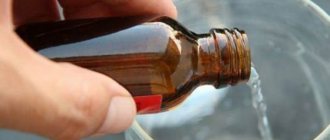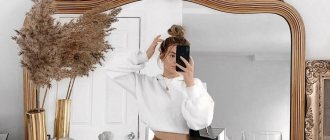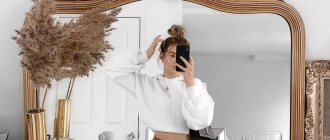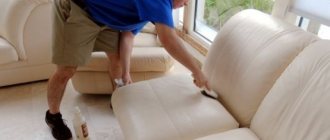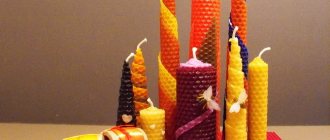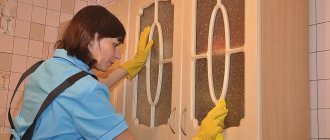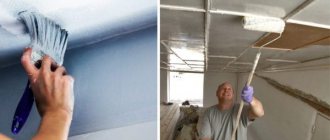What is MDF: composition and production technology of the board, features of the material
The abbreviation MDF comes from the English phrase “Medium Density Fiberboard” or the German “Mittel Dichte Fazerplatte” and is translated into Russian as “medium density fiberboard”.
This building material is made from wood fibers. Its production includes the following stages:
- Raw materials (sawdust, shavings, wood chips) are crushed to a powder state. To do this, it is first heated with steam to 100 degrees and brought to 80 percent humidity. After this, the mass is ground in a defibrator.
- Melamine-modified urea-formaldehyde resins and paraffin are added to the resulting powder.
- The mixture is dried with hot air at a temperature of about 200°. This procedure takes a few seconds.
- The raw materials are placed in a hopper where they are compacted.
- The mass is leveled by a roller along a conveyor. The result is a slab.
- The workpiece is pressed under a pressure of 350 MPa and heated to 230°. The sheets are compacted and become durable. Then the pressure is reduced by 3 times, and the thickness of the plates is adjusted without the help of high temperatures.
- The cooled workpiece is polished and cut into sectors.
This material is characterized by:
- moisture resistance;
- strength;
- availability;
- long life and ease of operation;
- the ability to decorate and create relief;
- resistance to sudden temperature changes and the influence of microorganisms;
- wide scope of application.
About patination
If you are not satisfied with the usual painting of MDF, you can order patination from us. This is the artificial aging of materials (objects) to give them an antique and sophisticated appearance.
As a rule, patination is used on matte MDF facades that have complex decorative elements. A special patination composition is applied without an additional primer layer (directly on top of the paint). To do this, use a spray gun, brush, roller or other device (depending on the inaccessibility of the treatment area).
After the patination composition has dried, its excess is removed using P320-400 abrasives or Scotch-brite sandpaper.
To protect the patina from dust and dirt, the finish is painted with acrylic matte varnish. Then the product is sent for drying.
Our company provides services for the manufacture and painting of furniture facades from MDF to many large companies in Moscow and the Moscow region and has established itself as a reliable partner; our products meet the highest quality criteria.
The production of MDF fiberboards started in the USA in 1966, so this material can be classified as young. However, in such a relatively short period of time, this type of wood-based panels has almost completely replaced wood from furniture production.
MDF has a medium density and is produced by pressing fine wood chips. The whole process takes place under high pressure and high temperature, and lignin, a natural substance, acts as a connecting link.
Most often, MDF boards are used for the manufacture of furniture facades for bedside tables and wall cabinets, and the main advantages of this material include:
- good indicator of resistance to moisture;
- resistance to high temperatures;
- strength;
- ease of use;
- low production cost and, as a result, low price on the market;
- resistance to fungi.
All of these properties listed above make MDF boards simply an irreplaceable material for the manufacture of furniture doors and facades. However, despite all its advantages, MDF, like any other material, eventually loses the brightness of its colors and is subject to natural wear and tear.
What to do in this case? There are two options for solving this problem - purchasing new furniture or restoring (painting) old facades, which will be discussed in our article.
Modern technology for painting MDF panels
Painting of surfaces made from MDF is done not only for decorative, but also for protective purposes. The main advantages of painting panels yourself:
- The coating is resistant to elevated temperatures, which allows you to place even hot dishes on the kitchen surface.
- High-quality painting of MDF with enamel allows you to make the facade more refined and original, giving it a unique design. For example, you can decorate your furniture with interesting decor in the form of pearls, mother-of-pearl, metallic and so on. To achieve this, various fillers are added to the paint.
- Safety for health, since only high-quality paints and varnishes are used.
Painted MDF panels not only look better, but are also more reliable and durable.
Disadvantages of painting MDF panels:
- higher price compared to film coating;
- If you use low-quality paint, over time the painted facade may fade under the influence of sunlight.
Correct and high-quality painting must be carried out in compliance with all the rules of the technological process. For the job you will need paint, wood primer or polyurethane primer, and varnish.
In order for a painted facade to look beautiful and not deteriorate over time, certain temperature conditions must be observed. It is best if all processes take place at a temperature of about twenty degrees. At the same time, air humidity should be in the range from 50 to 80 percent. The humidity of wood wall panels should be 8-15%.
Before applying paints and varnishes, they must be filtered using a 50-100 micron filter. It is advisable to filter twice if the paint has been stored for more than two weeks.
Reasons for the formation of defects
There are a number of reasons why painting MDF panels may be necessary, including:
- Mechanical damage to the surface as a result of impact with a sharp object or other material. The top layer of the MDF panel consists of laminated or plain paper with paint applied to it; when exposed to a hard object, the film breaks, which exposes the core of the entire product;
- Paint fading, loss of color brightness. This deformation is caused by exposure to ultraviolet rays and atmospheric air, which contains a small amount of moisture. Over time, the coating becomes matte, loses its shine and original appearance;
- Temperature changes also negatively affect the external condition of the surface of MDF panels, since the internal structure consists of wood, which absorbs moisture from the atmosphere and at the same time swells over the entire area. When the temperature rises, MDF dries out and may crack; moreover, the glue contained in the panel loses its ability due to moisture, which leads to peeling of paper, lamination and shavings.
These causes of deformation lead to an unsightly appearance of the entire surface and disrupt the overall design of the wall. If these defects occur, you can paint MDF panels after first completing a number of preparatory procedures, but you should understand that painting parts with your own hands at home brings a result that differs from processing with paints in production.
Can MDF be painted?
You can paint such items at home using:
- soil compositions;
- dyes with high hiding power, thixotropy, wear resistance;
- varnishes or polishing kits.
Painting MDF products is intended to:
- improve performance – we are talking, first of all, about items used in the kitchen or bathroom;
- refresh the interior;
- extend the life of products.
The following types of coloring compounds are suitable for painting MDF products:
- alkyd - plastic and durable, but have a tendency to fade under the influence of ultraviolet rays;
- oil - require mandatory preliminary priming of the working surface;
- silicone – elastic and resistant to high temperatures, suitable for painting products located near a gas or electric stove;
- water-based - dissolve in water, dry quickly, do not emit harmful substances, but do not have the best performance characteristics;
- acrylic-silicone - durable and absolutely harmless, but expensive;
- polyvinyl acetate - if the application technology is violated, they can peel off.
Panels with a glossy finish will cost more than matte ones. Their high cost is compensated by their excellent appearance. To create gloss on MDF products you can use:
- An alcohol-based varnish that dries quickly.
- Epoxy varnish that forms a durable layer.
- Acrylic lacquer. Low strength and a fairly short service life compared to previous types of similar products are compensated by safety - it does not emit toxic substances.
- Polyurethane, polyester and nitrocellulose varnishes. With their help, a very durable coating is obtained. In addition, they are resistant to any negative factors (high humidity, ultraviolet rays). Surfaces coated with such varnishes are easily polished.
We invite you to familiarize yourself with: Fabric glue types and best brands of glue, tips for use
. Facades, furniture panels, panels, door cladding and other products made from MDF are in great demand due to their characteristics. This is the only material among analogues that can be processed in all possible ways: milling, figured cutting, lamination, laminating, painting. Let's take a closer look at the latter.
This beautiful kitchen façade can be achieved using painted MDF
Painting MDF is a complex process and it begins with the selection of the base material – paint and varnish. If you want to get a perfectly smooth surface with a semi-matte or glossy sheen, then simple oil paint PF-115, even from an expensive foreign manufacturer, is not enough. An inexperienced master will face several problems at once:
- High absorbency of slabs, especially on sharp corners and milled bevels. The facades of furniture, doors or panels can almost completely absorb up to 5 layers of alkyd enamel. Without proper preparation, grinding and polishing, the surface will be uneven, rough, and untidy in appearance and touch.
- During transportation, the unprotected surface of MDF becomes covered with a huge number of scratches, both large and small. The paint fills them and reveals them first. Long grinding and constant monitoring will be required.
- When working, a milling tool literally tears out individual fragments, which causes small holes, dents and other defects to appear. Therefore, in addition to fine grinding, puttying with finely dispersed liquid compounds may also be required.
- Panels, doors and furniture elements made of MDF are almost always installed vertically, so drips, unevenness of the layer, etc. may occur.
- When working with a brush or roller, a large amount of so-called wood fluff rises, therefore, to obtain a smooth surface, sanding is necessary after each applied layer of paintwork.
Small roughness on the surface of MDF is the same “wood fluff”
It turns out that MDF cannot be painted? Our answer is that it is possible, but it is necessary to use a whole range of products, or, in the language of professionals, use a special program of paints and varnishes, which include:
- Several types of primer compositions: barrier primers or insulators with a pore-filling effect, elastic and easily sanded multicomponent compounds, basic pigmented compositions with a solids content of at least 50%.
- Paint with high hiding power, thixotropy, and after polymerization - wear resistance and durability.
- To create a smooth surface with a glossy/semi-matte sheen: varnish or polishing kits (paste, nap disc for polishing).
How to work with it?
As with any other paintwork. Let's look at the specification for it. You can read about what the technical specification for coatings is and how to use it by following this link.
We find the mixing recipe, press the can, load it into the spray gun for stain, find out which gun to use for stain here, and coat the product.
This is the moment! You don’t need too much insulator, it just doesn’t make sense to fill it with a thick film, it should be absorbed into the ends, where it is absorbed most strongly and raises the pile, that’s enough.
I repeat once again, there is no need to pour in five layers until the film appears!
I’ll try to explain: MDF is paper, like any paper, it absorbs moisture. Soil is moisture... When applied, it wets the outer layer of MDF and, due to the high drying speed, impregnates only a few millimeters from the outer edge, accordingly, hardening, changes the structure of MDF to a more dense one, at the point of penetration... which does not allow the main, next one to be further impregnated behind the ground insulator.
I always say that we are all different and everyone perceives information in their own way... some on the spot, without a word, while others seem to understand everything, but for the whole picture something is missing... as a variant of such an explanation
Preparing for coloring
Even an inexperienced painter can paint the facades of a kitchen unit, cabinet or door made of MDF. To ensure that no problems arise during the painting process, and that the result pleases you with its impeccable execution and uniform application of paint, you need to properly prepare for this procedure. It is necessary not only to organize the workplace, but also to prepare the surfaces to be painted for the application of the coloring composition.
Before painting, it is recommended to disassemble the furniture or at least remove the kitchen facades from their hinges. Firstly, it will be much more convenient to apply paint and varnish to the surface, and secondly, it will protect parts that do not need to be coated from being carelessly applied to them with a coloring composition.
Before starting work, it is necessary to thoroughly wash and degrease working surfaces. This can be done with a solution prepared from dishwashing liquid, as well as vodka or alcohol. Next, you should repair the cracks and chips. To do this, use wood putty.
In order for the paint composition to lie evenly on the work surface and form a reliable adhesion to it, it is necessary to sand it. To do this you will need sandpaper and a grinder. Small areas should be treated with sandpaper on foam rubber of P220-P280 gradation, large areas with sanding mats with fine grit of the 700 series.
It is necessary to ensure that scratches do not appear on the laminating film. Dust is removed from the treated areas using a vacuum cleaner, then they are washed with a solvent. After sanding, the surfaces become matte and rough to the touch.
Application of primer
Priming is one of the most important stages in preparing the work area for painting. A properly selected primer performs several functions:
- promotes reliable adhesion of paint to the surface being painted;
- makes the top layer durable;
- masks minor defects;
- prevents pile raising on MDF;
- reduces absorption, reducing dye consumption.
The most commonly used are 2-component polyurethane and water-dispersed primers. Priming is performed in 2 stages:
- The end and protruding elements are primed, after which the entire part is processed. After the insulating layer has dried, the raised fibers and other defects are cleaned, for example, with a P220-240 sanding sponge. During the sanding process, it is important not to overdo it and not to rub the primer layer to the base.
- After removing dust from the sanded surface, it is primed again, applying a layer of white polyurethane primer at the rate of 150–200 g per 1 square meter. m. It will take from 8 to 24 hours for it to dry completely. The completely dry surface is sanded with P320-400 sandpaper. Hard-to-reach and protruding areas are sanded with a Scotch-Brite sanding sheet.
We suggest you read: How to make a deflector for a chimney yourself
The most convenient way to paint is with a spray gun. However, not everyone has such a device. If it is not possible to purchase this device, a regular fine-nap roller or brush will come to the rescue. When purchasing a roller or brush, it is recommended to consult with a sales consultant, telling him what type of paint and varnish you plan to use.
Many experienced painters prefer to use spray paint. This method has both advantages and disadvantages. The first includes uniform application of the paint and varnish and, as a result, an ideal result. The main disadvantage of this method is the need to carry out work in a separate room, which you don’t mind getting dirty. No matter how carefully the table, floor, baseboards, and household items are covered, when using a spray can the coloring composition will inevitably get on them.
To prevent paint poisoning and protect yourself from its splashes, you must wear a respirator, safety glasses and rubber gloves while working. If a speck gets onto a painted surface that has not yet set, you need to remove it by carefully prying it off with a sharp object, such as a knife. If you notice a defect in this place after drying, you need to carefully sand it and tint it with a cotton swab, making light blotting movements.
Usually, after painting, varnishing of the product is required. The working surface must be absolutely dry. There should be no debris or dust on it, since any lint will be visible in the light. Varnish is applied at the rate of 150 g per 1 sq. m. The first layer should be very thin so that drips do not form. Each subsequent layer of varnish is applied only after the previous one has completely dried.
After varnishing is completed, the surface must be sanded. This is done first with coarse-grained sandpaper, and then with fine-grained sandpaper. To prevent pellets from appearing during work, the work area is periodically moistened with water. After 7 days, the varnished surface must be polished with a grinding machine using an abrasive paste. Only by following this technology will you get a perfectly smooth, shiny surface.
Paint application instructions
Before painting MDF, it is necessary to clean the surface from any dust that remains after finishing sanding. It is better to do this by degreasing. Below we provide a detailed description of the technology for painting MDF facades. Is it possible to do the work when painting MDF with your own hands using a paint brush? I guess, yes. But the result will not be perfect. So, they repaint the furniture according to this algorithm:
- The first rule: prepare the dye for application according to the manufacturer's instructions.
- We fill the sprayer and adjust its operation so that the capture area is small. This will allow you not to waste extra material and paint more thoroughly.
- The process of applying the coloring material also begins with the most problematic areas, and then moves on to the main area.
- It is better to apply several layers. The painted products are dried at intervals of about 20 minutes.
If you have no experience working with a spray gun, then it is necessary to carry out training work on some test workpiece.
In the video: mistakes when painting with a spray gun.
After painting the MDF, it should be coated with furniture varnish, which allows you to create a gloss. The process is exactly the same as when applying paint. But you should prepare for it more carefully. The room in which work is performed must be perfectly clean. If the workshop is dusty during varnishing, then it will be difficult to achieve a mirror gloss.
The interval between applying layers of varnish should be about 10 minutes. After complete drying, polishing is performed.
This is not to say that the technology for painting MDF is simple. This is quite labor-intensive work. If you have not previously dealt with MDF boards and their processing, then first you should practice and paint old and unnecessary furniture. As soon as it starts to work out, painting the MDF facades is done on your favorite furniture. If there are any doubts, then it is better to leave it to the professionals from the Ruhlman company.
Painting MDF facades (1 video)
Hi all! In this short article we’ll talk about what a soil insulator is.
.
We will talk about primer insulator for MDF
.
Soil insulator
- The primer is designed for use as a sealing primer in pigmented polyester and polyurethane coating systems on MDF products to prevent absorption and lint lifting.
In my practice, I have met companies that either on principle, or out of ignorance, or because of saving money, avoid this primer when painting. Or fill it with MDF like regular primer... :).
Let's figure it out
Why is this soil needed?
Is it possible to do without it?
And
how to work with it?
Before I figure it out, I’d like to explain why I started blogging less often... Are you out of thoughts? no topics to write articles on? laziness? no, everything is in order, thoughts and themes and laziness... everything is there, it just so happened that I had to change my place of residence and work. I think I already mentioned in some article that I moved... well, everything is clear with housing, but work... I had to do a fair bit of running around. By the way, I wrote an article on the topic “How to find a job“
There is a lot of work, you just need to choose a normal one. You work in one company for a week, you realize that not everything is as good as it looks at first, you look for a new one... and so on until you find something suitable... You waste nerves, energy, money, and most importantly time... And you need to draw inspiration from real orders, posting on blog photo... Now I have found a small company that seems to suit me (ugh, ugh, ugh, no matter how I jinx it) I hope to get into the usual rhythm of working and writing articles... so as not to miss the latest articles, I recommend subscribing to my blog news
Well, okay, this is all great, of course, but let’s talk about the soil...
Selection of painting equipment
To paint MDF with your own hands, it is advisable to have a room of at least 40 square meters, equipped with a special painting chamber and a place for sanding surfaces. In addition, a place should be provided for storing wooden blanks and finished panels.
The temperature in the room where the façade or interior surfaces will be painted must be at least twenty degrees. It is best to equip the painting chamber with a hood and a rotating tabletop. The drying room for finished parts must have shelving. It is best to equip the place where you plan to sand with reliable vacuum cleaners.
Modern painting technology involves applying paints and primers using a pneumatic spray gun with a 1.5-2 mm nozzle and a receiver compressor with a capacity of at least 80 liters. If powder paint is used, it is applied using a sprayer directly to the surface. It is best to grind parts using a vibrating sander. Polishing is carried out with an angular grinding machine.
Technology for painting furniture facades made of MDF
This is not an easy job, requiring painstaking skill, little skill and extreme care. Everything is done in several stages, and the final quality of painting depends on the quality of each of them. If you do not plan to paint the panels yourself, but want to call a specialist, then check the price per m2 in advance. If you do the work yourself, then study the steps in more detail.
Tools
You can use various tools to apply paint. The most basic thing is a brush, roller or spray gun. Everything directly depends on professionalism, budget and personal preferences. Remember that a more optimal result is achieved using a spray gun or spray gun. Using a spray gun you can not only paint, but also prime.
Two types of pistols have been developed: electric and pneumatic. The latter operate on the basis of air, which is pumped by a compressor, and the former from a regular electrical outlet.
If you purchase a brush or roller, then pay attention to the markings, which indicate what composition they should be used for.
The equipment for painting has been selected, now you need to select auxiliary materials. Among them: sanding pad (Scotch-brite), sandpaper of various grain sizes, solvent, markers, masking tape, anti-silicone and degreaser. Do not forget about personal protective equipment: gloves, work clothes and respiratory protection (respirator or cotton-gauze bandage).
The topmost layer on MDF is most often a glossy coating (paint or varnish). If it is not removed, the new layer will not be able to take hold. Therefore, the top must be treated with the coarsest sandpaper. It is not necessary to remove all the paint, the main thing is to make the surface rough.
The old coating can also be removed using special removers; if we are talking about acrylic paint, you can use a solvent.
Another option for surface preparation is a paint dryer (torch). It can be used for polyester coating. The varnish cracks under the influence of high temperature, and then it can be easily removed with a chisel or spatula.
We suggest you read: How to get a dark red color - How to get a burgundy color when mixing paints: options and combinations of shades -
Grinding
To obtain a high-quality coating, you need a perfectly smooth surface. To obtain it, you must first grind the surface. Certain sanding steps require sandpaper of varying grits. P220-280 is used to prepare the base for primer, P320 is used to remove uneven ground, and P500 is sanding before applying paint.
For delicate and final sanding, use non-woven felt or Scotch Brite.
Painting
Painting MDF facades is not particularly difficult. When using a spray gun or gun, be sure to protect your respiratory tract. Keep the device at least 15 cm away from the façade. Please note that the movements should go in one direction so that the paint lays evenly.
If the technology is followed, the paint lays down smoothly and creates a perfectly flat surface. To make the tone deeper, you should apply another layer. Please note that if you are doing two layers, then the first one needs to be slightly disturbed with sandpaper so that the second layer is better secured.
Applying varnish
The varnish is usually applied in one layer, but more can be applied, but not more than three, to get a more concentrated result. Before applying varnish, the surface must dry thoroughly, which usually takes several days. The first layer is a light spray so that there are no drips for the next layer.
If you do the painting yourself, keep in mind that it is not advisable to do it outside, because dust or settled lint will be very noticeable in the light. Important: each layer of varnish needs time to dry - at least 10 minutes. If this requirement is met, you will get an ideal glossy facade with a mirror finish.
Final sanding of the facades using P500 sandpaper. Please note that the thinnest layer is always on the ends, which means sanding is done delicately. At the final stage, go over with Scotch Brite.
If desired, do some decorating. If you do the work at home, then use polishing, enamel, regular varnish or glazing. The latter is a translucent paint for the kitchen facade, which in appearance resembles marble stains. To do this, dilute it with water and apply in several layers.
Video
Perhaps there is not always enough money to update the interior. Painting MDF is a solution if the furniture frame is intact, but you want to transform or change the design. You can try to repaint the facade of the kitchen or other MDF furniture yourself.
It’s good that modern technologies and materials make it possible to paint MDF at home quite efficiently. Let's take a closer look at how to paint MDF facades with your own hands using standard technology.
Painting MDF facades is a rather labor-intensive process that requires patience and diligence. And also purchase high-quality materials to get a good result. The materials used to make furniture are wood or furniture boards. Recently, the use of MDF facades has become increasingly popular. To repaint furniture, you need to prepare materials that are standardly used for wood processing. These include:
- Sandpaper with varying degrees of abrasiveness.
- Masking tape.
- Equipment for painting facades (spray gun).
- Various compositions for degreasing, priming, painting.
Let us consider in detail what these materials are and what function they perform.
Sanding paper
For the process of sanding MDF boards, ordinary sandpaper is used. It is used with varying degrees of abrasiveness and at different stages. In each individual case, the sandpaper grit changes. MDF is a fibreboard that is processed similarly to wood. Thus:
- When preparing the surface for priming, we will use 220-280 grit sandpaper.
- To remove uneven application of primer, use sandpaper with an abrasiveness of 320.
- Final sanding before painting is done with 500 grit sandpaper.
For ease of work, you can use sandpaper with a foam or felt base.
Sprayer for painting
You can paint MDF facades yourself using paint brushes or rollers. This is a completely acceptable option, but it will be impossible to achieve a flawless surface. Therefore, it is better to use paint sprayers to process MDF furniture with your own hands. In addition to the quality of application, the spray gun will make it possible to speed up the process.
Advice! Use paint sprayers for the priming process as well. This will significantly speed up the application of primer.
Paint sprayers are divided into two types: electric and pneumatic. You should also pay attention to the diameter of the spray rod. For painting MDF, rods with a diametrical cross-section of 1.2 - 1.3 mm should be used so that the painting material is applied in a very thin and uniform layer.
Degreasing agents
A very important point before starting to paint MDF furniture facades is to carry out the procedure of degreasing the surface. If you ignore this process, then after completing all the stages, defects may be discovered that can only be corrected by doing everything completely again. Degreasing of MDF facades is carried out using compounds that contain organic solvents. Such products successfully remove various oils and fats. They also work well with polyorganosilicones.
Types of primers
Furniture facades cannot be painted without a priming process. This is also one of the guarantees of high-quality work. It is priming that will ensure reliable adhesion of the surface of the facades with paint and paint compositions. You can use several types of primer that are also suitable for MDF surfaces:
- for plastic surfaces;
- epoxy;
- steam-filling.
It is not recommended to treat natural wood surfaces with epoxy primer. And prime MDF boards one by one with all primers: plastic, epoxy, vapor-filling.
Painting materials
There are two types of enamel paint for MDF:
- alkyd based;
- on acrylic base.
The first is a derivative of alkyd resins. You can quickly paint MDF panels with this paint, since after application to the surface it quickly hardens at optimal temperatures and humidity levels. Costs less than acrylic, but requires final varnishing.
Acrylic enamels are more convenient when working with MDF, since they absolutely do not require applying a varnish layer. After treating the surface of this type of paint, an ideal glossy layer is immediately formed.
On video: MDF painting technology.
Painting stages
At the preparatory stage, you need to pay great attention to the processing of the slab. To treat the surface to a glossy finish, you need to avoid raising the pile and eliminating embossing that occurred during the production process.
The MDF facade should be milled at maximum speed, which will avoid raising the pile. Since the paint layer here is very thin, it is advisable not to leave sharp corners that can be easily knocked off. For cutting corners, it is best to use an edge cutter with a radius of about 3 mm.
To properly sand the MDF facade, it is necessary to remove the surface protective wax layer from the entire surface. An eccentric type grinder is best suited for this work. To process complex curves, it is advisable to use sandpaper. If you plan to paint MDF wall surfaces that include several component elements, then it is better to properly fill the joint gaps with a primer to fill the pores.
Why is this soil needed?
The insulating primer is designed to prevent the absorption and raising of pile. That is, before applying the base primer according to the rules of the MDF finishing system, you need to cover the product with an insulating layer. Otherwise, the pigment will fail and fail mainly at the ends and milling areas...
On my own behalf, I can add that thanks to the insulator you can save on layers of pigment primer...
Without applying an insulator, to achieve the desired result, you will have to cover at least one more layer of base primer.
Decorating painted furniture
When painting MDF products, it is not at all necessary to limit yourself to applying varnish. To breathe new life into a familiar interior, you can resort to decoration. There are many ways to decorate painted surfaces:
- Artificial aging. To imitate antiquity, special patination compounds are required. With their help, emphasis is placed on individual elements: frames, plinth, parts with cutters.
- Decoupage. A design is attached to the product (for example, cut out of a paper napkin) and varnished. Most often, this decorative option is used in interiors designed in Provence style.
- Application of patterns and drawings. Products are decorated using ready-made or self-made stencils.
- Decorative flaws. Irregularities, chaotically located strokes, bubbles, and dents are created. They often resort to the following technique: they apply glisal, after which they create fancy embossing on it with sponges, brushes, seals, textured rollers, etc.
- Decoration with rhinestones, crystals, stones and other decorative elements. Handles or other small details are decorated in this way.
- Glaze. Using this technique, beautiful deep iridescent shades are achieved. This effect is achieved by applying a translucent composition over the base color.
- Raindrops. This decor option involves the use of 2 colors. First, apply a rich shade product. After it hardens, water is sprayed from a spray bottle onto the work surface. Without waiting for it to dry, paint of a different color is applied on top using a light spray technique. After the paint composition has completely dried, the area to be decorated is sanded and varnished.
I hope the recommendations outlined will help you achieve your plans. More information in the video below.
About grinding and polishing
When grinding, an eccentric machine is used. The worker also treats the MDF surface with sandpaper (starts with P1200-1500, and then moves on to P3000-4000). When sanding, the surface to be treated is doused with water from time to time to prevent overheating and prevent varnish particles from rolling off. After all sanding operations, a uniform matte finish should be obtained.
When polishing, an angle machine with a white foam rubber wheel is used. In this case, paste is applied to the treated surface of the facade (parts) made of MDF. As a rule, the abrasive composition Bril-852 is used.
Polishing is carried out at working speed (1500-2000). But before this, the abrasive paste is evenly rubbed onto the MDF using a machine (less than 1500 rpm). To make the polishing process more effective, the polishing wheel is wetted. In addition, a small amount of special furniture wax is applied to it.
At the last stage, a non-abrasive Siashine FINISH compound and a soft black foam polishing wheel are used.


